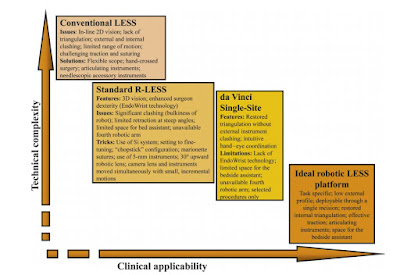The way of single-port devices
If you are interested in the landscape of single port surgical tools and LESS robotics, check out the review article of European Urology: "Current Status and Future Directions of Robotic Single-Site Surgery: A Systematic Review".
"Context: Despite the increasing interest in laparoendoscopic single-site surgery (LESS) worldwide, the actual role of this novel approach in the field of minimally invasive urologic surgery remains to be determined. It has been postulated that robotic technology could be applied to LESS to overcome the current constraints.
Objective: To summarize and critically analyze the available evidence on the current status and future of robotic applications in single-site surgery.
Evidence acquisition: A systematic literature review was performed in April 2011 using PubMed and the Thomson-Reuters Web of Science. In the free-text protocol, the following terms were applied: robotic single site surgery, robotic single port surgery, robotic single incision surgery, and robotic laparoendoscopic single site surgery. Review articles, editorials, commentaries, and letters to the editor were included only if deemed to contain relevant information. In addition, cited references from the selected articles and from review articles retrieved in the search were assessed for significant manuscripts not previously included. The authors selected 55 articles according to the search strategy based on Preferred Reporting Items for Systematic Reviews and Meta-analysis criteria.
Evidence synthesis: The volume of available clinical outcomes of robotic LESS (R-LESS) has considerably grown since the pioneering description of the first successful clinical series of single-port robotic procedures. So far, a cumulative number of roughly 150 robotic urologic LESS cases have been reported by different institutions across the globe with a variety of techniques and port configurations. The feasibility of robot-assisted single-incision colorectal procedures, as well as of many gynecologic procedures, has also been demonstrated. A novel set of single-site instruments specifically dedicated to LESS is now commercially available for use with the da Vinci Si surgical system, and both experimental and clinical use have been reported. However, the current robotic systems were specifically designed for LESS. The ideal robotic platform should have a low external profile, the possibility of being deployed through a single access site, and the possibility of restoring intra-abdominal triangulation while maintaining the maximum degree of freedom for precise maneuvers and strength for reliable traction. Several purpose-built robotic prototypes for single-port surgery are being tested.
Conclusions: Significant advances have been achieved in the field of R-LESS since the first reported clinical series in 2009. Given the several advantages offered by current the da Vinci system, it is likely that its adoption in this field will increase. The recentintroduction of purpose-built instrumentation is likely to further foster the application ofrobotics to LESS. However, we are still far from the ideal robotic platform. Significantimprovements are needed before this technique might reach widespread adoptionbeyond selected centers. Further advances in the field of robotic technology are expectedto provide the optimal interface to facilitate LESS."



Comments